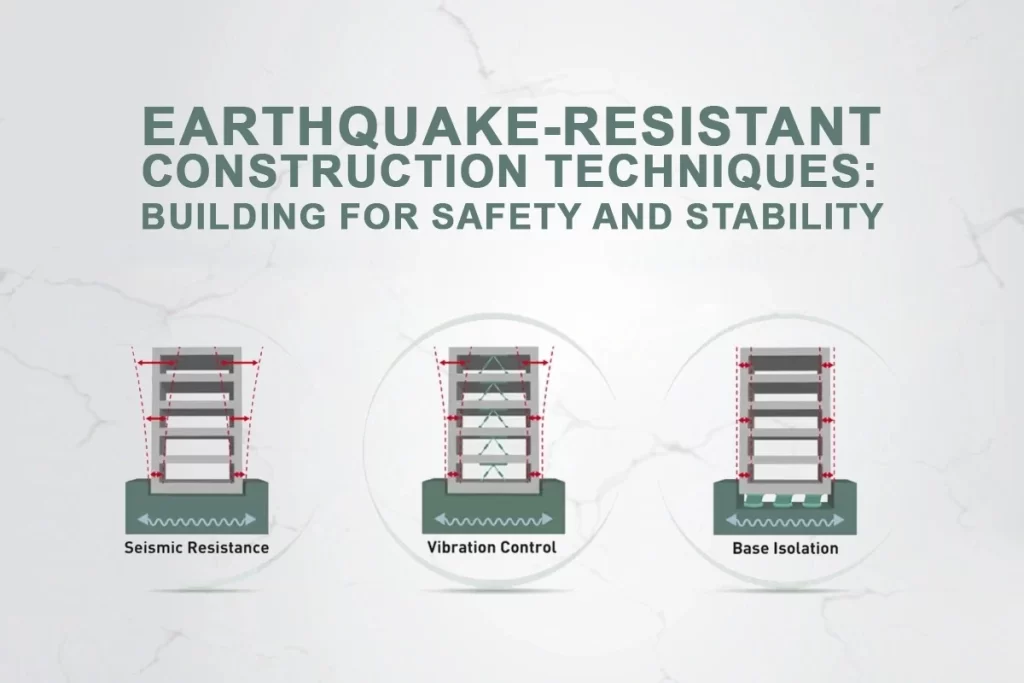In the aftermath of earthquakes and other natural disasters, there is often widespread destruction and chaos. Collapsing buildings and homes can lead to significant casualties. Ensuring that your home or building is earthquake-resistant is crucial for safety. Here’s how you can make your home more resilient to earthquakes.
Safe Practices for Earthquake-Resistant Construction
The ability of building materials to withstand an earthquake depends not only on their resilience and strength but also on how they are integrated into the structure. For example, a long, straight stone wall that relies solely on friction and geometry to hold stones in place is likely to collapse during an earthquake. This is because the mass or inertia of the wall causes its motion to lag behind the earth’s movement during a quake. This can shift the wall’s weight out of the stable load line, causing it to tilt over and dislodge the stones, leading to collapse.
Below are some earthquake-resistant construction techniques that you can use to build your home:
1. Bands
Horizontal bands are a method of reinforcing masonry structures by providing bands with higher tensile strength. This reinforcement is applied where two structural elements of a building meet, allowing them to behave as a single unit during an earthquake.
Horizontal bands are used at the following levels:
- On the building’s plinth level
- At the lintel levels, such as doors and windows
- At the roof levels
Types of Horizontal Bands:
- Roof band
- Lintel band
- Gable band
- Plinth band
2. Waste Tire Pads
This method involves using low-cost seismic base isolation pads made from scrap automobile tires. Seismic base isolation is a well-established earthquake protection system that has been extensively studied. While much of the research has focused on improving the performance of these systems, this method aims to reduce the cost and weight of seismic base isolation pads by recycling scrap tires. For the past 30 years, elastomer-based isolators have been widely researched and used. In these isolators, steel or fiber reinforcement provides high vertical stiffness, while rubber segments between reinforcement layers offer low horizontal stiffness.
3. Haunches
Joints are the most vulnerable parts of a structure during an earthquake, and most structural failures occur due to joint failure. Resistance can be enhanced by increasing joint strength. This can be achieved by using high-strength or fiber-reinforced concrete or by increasing the section near the joints or providing haunches, which stiffen the joint.
4. Hollow Foundation
Secondary and Love waves are the most destructive of all earthquake waves. Since secondary waves cannot travel through water, a hollow-type raft foundation filled with water can help mitigate some of the destructive effects of an earthquake. The foundation could be filled with a viscous fluid to act as a damper, reducing the impact of seismic waves.
5. Sliding Joint
The sliding joint concept is based on the idea that the force transmitted to the superstructure will be limited to the force required to slide the joints, and the energy dissipated during frictional sliding will not be transmitted to the superstructure.
Seismic Reinforced Materials at Low Costs
Implementing earthquake-resistant construction techniques doesn’t have to be expensive. Here are some material-specific methods that can enhance the seismic resilience of various construction types without incurring significant additional costs.
Wood Frame Construction
Wood frame construction can be made more earthquake-resistant by incorporating the right brackets, hold-downs, and fasteners. Although screws might appear to have greater holding power, they tend to be brittle and can break under load, whereas nails offer more flexibility. Common reinforcement techniques for wood frame construction include the use of shear walls, brackets, and gussets to strengthen beams, joints, corners, sill plates, and roof trusses.
Adobe and Rammed Earth Construction
The heavyweight and brittle nature of adobe and rammed earth walls make them especially vulnerable to seismic failure, particularly at corners and along long walls. This vulnerability can lead to large sections of the structure collapsing during an earthquake. To mitigate this risk, reinforcement fibers, bars, rods, or mesh can be integrated into the walls to reduce cracking and keep the structure intact.
Internal Reinforcement Methods
In adobe and rammed earth construction, internal reinforcement can be achieved by using materials such as straws, vines, or synthetic yarns. Additionally, ropes, plants, vines, twines, or bamboo can be utilized to connect wooden bars and rods at intervals, attaching them to foundations, wall caps, and each other. This method is especially effective at corners, where mesh reinforcement, such as screens or chicken wire, can be employed to connect walls and better distribute horizontal forces.
Conclusion
When it comes to building structures that can withstand the forces of an earthquake, the choice of materials is just as important as the construction techniques used. SRMPR Cements offers exceptional strength and durability, making it an ideal choice for earthquake-resistant construction. Its advanced formulation ensures enhanced bonding and flexibility, which are crucial in preventing structural failures during seismic events. By choosing SRMPR Cements, you’re investing in the safety and stability of your home or building, giving you peace of mind in the face of natural disasters.
Ensure your construction projects stand strong against earthquakes by opting for SRMPR Cements a reliable partner in building for safety and stability.



